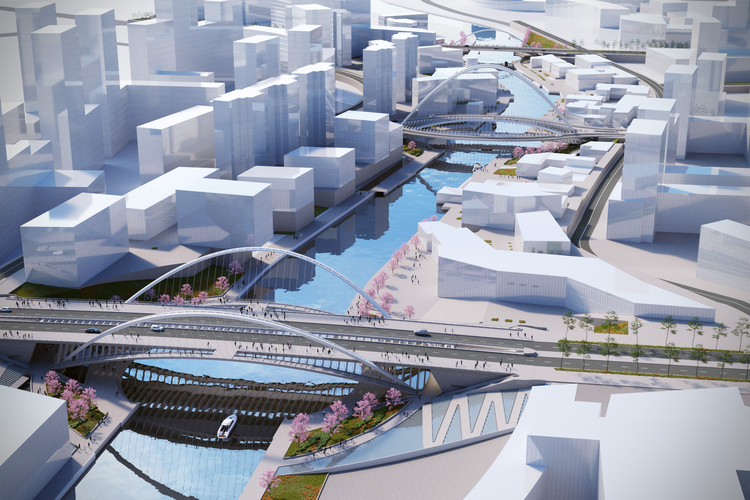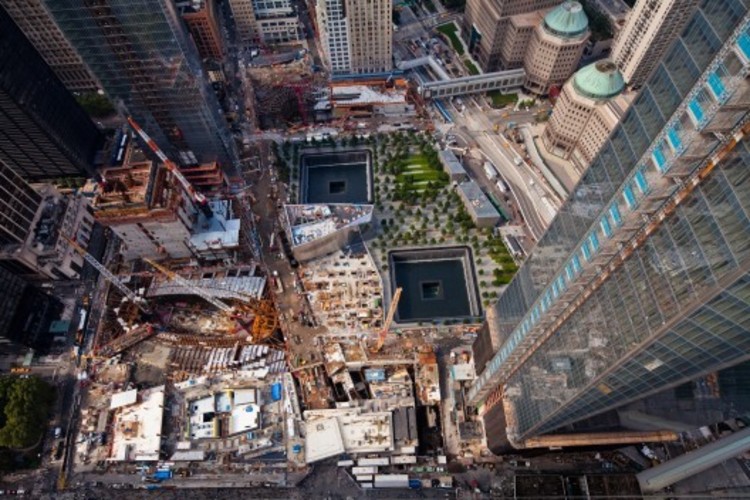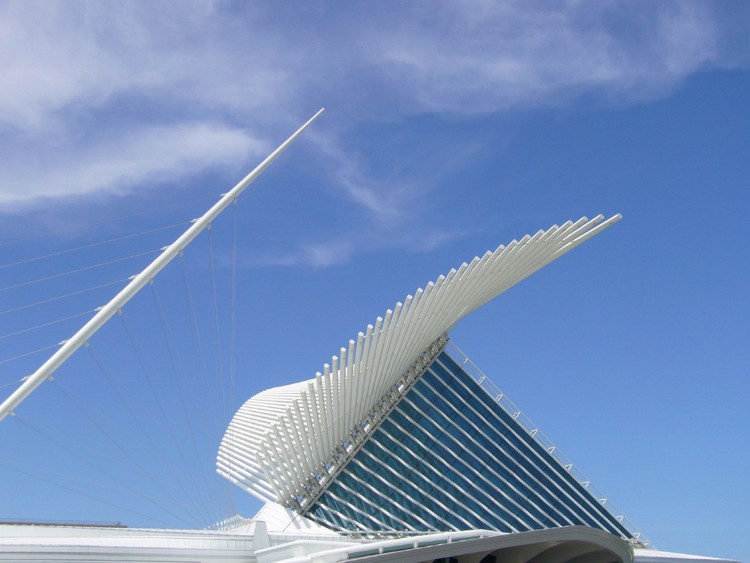If you haven't had the opportunity to step inside Santiago Calatrava's World Trade Center Oculus, here is your chance. Miguel de Guzmán of Imagen Subliminal has captured the incredible space in VR (Virtual Reality), granting you 360-degree views of the infamous oculus. Put on your Google Cardboard and see it for yourself.
Santiago Calatrava: The Latest Architecture and News
If You Haven't Seen Calatrava's World Trade Center Oculus In Person, This is Pretty Darn Close
Video: Time-Lapse of Santiago Calatrava's World Trade Center Oculus
Santiago Calatrava's long-awaited World Trade Center Oculus has officially opened. Thanks to EarthCam and the project's contractor Skanska USA, you can watch the $4 billion transportation hub take shape over the course of 42 months in just 65 seconds, from June 2011 to December 2014. For more, see what the critics have to say about the newly opened building here.
With the Opening of the WTC Transportation Hub, Has Santiago Calatrava Been Vindicated?

After 12 long years and a series of construction headaches, Santiago Calatrava’s $4 billion World Trade Center Transportation Hub has finally opened to the public. Once widely regarded as a symbol of hope for post-9/11 New York, the project’s ballooning budget and security-related revisions gradually soured the opinions of the public and top design minds including Michael Graves and Peter Eisenman, and provoked a multitude of mocking nicknames ranging from “Calatrasaurus” to “squat hedgehog” to “kitsch dinosaur.” All the while, Calatrava urged critics to reserve their opinion until the project’s opening. Now that day has arrived - did Calatrava receive the vindication he was insistent would come? Read on for the critics’ takes.
Santiago Calatrava's WTC Transportation Hub to Open Next Week

Half of Santiago Calatrava's $4 billion World Trade Center Transportation Hub is set to "quietly" open next week, according to a report by Crain's New York. Heavily criticized for being seven years overdue and twice its original cost, the public project has been labeled a "symbol of excess" by some and a "legacy project" by others. Despite the criticism, its 355-foot-long operable "Oculus" is "breathtaking" says New York Times reporter David Dunlap.
“It is necessary,” Calatrava told Dunlap, “that public space prevail... A balance is struck at Grand Central Terminal, and it will be here."
Santiago Calatrava Wins Competition to Design Landmark Observation Tower in Dubai

Santiago Calatrava has won an international competition to design a "landmark" observation tower in Dubai Creek Harbor. Selected over five other proposals, the design was inspired by Islamic architecture with the intention to "fuse modern, sustainable design with the rich culture and heritage of the United Arab Emirates."
“This architectural wonder will be as great as the Burj Khalifa and the Eiffel Tower,” said Sheikh Mohammed, Vice President and Prime Minister of the United Arab Emirates.
AD Interviews: Santiago Calatrava on the Museum of Tomorrow
Last week marked the opening of Santiago Calatrava's Museum of Tomorrow in Rio de Janeiro. Prior to the its opening, ArchDaily sat down with Calatrava to learn more about the museum's design and how the project's fruition resulted in the removal of an elevated highway that once isolated the city from the harbor.
Santiago Calatrava's Museum of Tomorrow Opens in Rio de Janeiro
.jpg?1450368012)
Santiago Calatrava is celebrating the opening of the Museu do Amanhã (The Museum of Tomorrow) this week in Rio de Janeiro. The highly anticipated museum, built on the Pier Mauá, features a distinct cantilevering roof that stretches 75-meters over the museum's 7,600-square-meter plaza and 45-meters towards the sea.
"The city of Rio de Janeiro is setting an example to the world of how to recover quality urban spaces through drastic intervention and the creation of cultural facilities such as the Museum of Tomorrow and the new Museum of Art,” said Santiago Calatrava. "This vision led us, in our first designs, to propose the addition of a plaza outside the Museum. The plaza creates a more cohesive urban space and reflects the neighborhood’s greater transformation.”
Santiago Calatrava Designs 3 New Bridges for Huashan

Santiago Calatrava has been commissioned to design a trio of bridges in the Chinese city of Huashan, east of Wuhan. The three steel bridges - Xihu, Xianbi and Lincong - will span 1.5 kilometers of the city's new Yangtze River canal, providing access to pedestrians, cyclists and vehicles.
“Architecture is one of the art forms best able to improve and revitalize cities both artistically and functionally,” said Calatrava. “The Huashan project is a clear example of how an urban element, key to the successful growth of the city, can at the same time improve the quality of life for its citizens, thanks to an integration of all three bridges and the creation of boulevards on the banks of the canal.”
Leaking Water Becomes Latest Setback for the World Trade Center Hub

Adding to the controversy surrounding its construction, Santiago Calatrava’s World Trade Center Hub - set to be the world’s most expensive transit hub with a now-estimated budget of $3.7 billion - has delayed its opening until the first half of 2016 due to leaking water, according to an article in The New York Times. The water, originating from the site of an office tower to-be at 3 World Trade Center has been traced back to workers constantly spraying water to handle dust while breaking up concrete, exposing the construction site of 3 World Trade Center to the elements. Though the centerpiece of the Hub, The Oculus, has nearly finished construction, several retail spaces of the Westfield World Trade Center luxury shopping centre have been affected by the leaking and the Westfield Corporation has decided to postpone the move-in of all stores until the problem has been fully addressed. Despite the problems, the Westfield Corporation remains optimistic of the final result that the Oculus will produce and are working aggressively to remedy the leaking.
Santiago Calatrava Awarded the European Prize for Architecture

The Chicago Athenaeum Museum of Architecture and Design and the European Centre for Architecture, Art, Design and Urban Studies have announced Santiago Calatrava as the winner of their 2015 European Prize for Architecture. Calling Calatrava "a visionary theorist, philosopher and utopian and a true artist in the craft of engineering and architectonic expressionism," president of the Chicago Athenaeum Christian Narkiewicz-Laine noted that "it is significant that The European Prize for Architecture honors Calatrava as an architect, engineer, sculptor, and painter.”
Santiago Calatrava Discusses the WTC Transportation Hub
In this additional scene from our interview with Spanish architect/engineer Santiago Calatrava, the designer discusses the monumental timespan and demanding criteria of his transportation hub for the World Trade Center. Following Calatrava’s aesthetic calling card, the project’s ribbed vocabulary and “birdlike” form features a 355-foot-long operable Oculus - a "slice of the New York sky" - that casts a soft glow onto the pristine white surfaces of the interior. New areas of the building opened to the public this summer, with the project slated for a grand opening this December.
AD Interviews: Santiago Calatrava
Earlier this year we had the chance to interview Spanish-born architect Santiago Calatrava in his New York apartment. Trained first as a structural engineer, he has designed and completed over 50 projects, which include bridges, transportation hubs, theaters and even a skyscraper. Calatrava has built a career through public architecture, and thanks to open competitions he has received commissions for mostly large-scale, cultural and transport projects. Many cities around the world—from Europe to the US and Asia and beyond—can proudly lay claim to the structurally dramatic projects that Calatrava has dreamed up.
His architectural explorations fuse engineering and art, and result in impressive structures that are honest in revealing the forces at play. In this respect, he is a pioneer; when working on his earliest projects, he didn’t have access to software and tools that are ubiquitous today.
We asked him about his definition of architecture, his high-profile commission for the World Trade Center Transportation Hub, and the challenges he has faced while running his practice. The WTC hub is one of Calatrava's most-anticipated projects in New York; though its inherent complexity has resulted in a long construction period, he has created a project rich in not only form, but also in spatial quality.
Some of Calatrava's projects use an almost modern-day gothic vocabulary—where big spans, vaults and thin lines define large spaces. Other works, such the St. Nicholas Cathedral in New York, mobilize larger masses and big, stacked walls.
Watch the interview above to learn how Calatrava sees the intersection of art and architecture.
Santiago Calatrava's Florida Polytechnic Building Named "Project of the Year"

Santiago Calatrava's Innovation, Science and Technology (IST) Building at Florida Polytechnic University has picked up another award, this time being named "Project of the Year" by Engineering News-Record. The "centerpiece" of the new Floridian university, which was also masterplanned by Calatrava, the 162,000-square-foot building was recently awarded "Best in Steel Construction" by the AISC.
“Educating, particularly young people, is one of the most noble tasks that exist,” said Calatrava in response to the award. “The Innovation, Science and Technology Building aims to be itself a tool to achieve the highest level of education for young people.
Santiago Calatrava Tops Out on Dallas' Margaret McDermott Bridge

Santiago Calatrava has topped out on his second Dallas bridge - the Margaret McDermott Bridge - two years after completing the Margaret Hunt Hill Bridge. The steel arch, reaching a height of 275 feet, is the first of two that will support the 1311-foot-long bridge that is intended to provide access to pedestrians, bicyclists and cars over the Trinity River. The $113 million bridge is part of the massive $798 million Dallas Horseshoe Project that aims to alleviate traffic and enhance accessibility downtown. It is scheduled to complete by the summer of 2017.
Santiago Calatrava's Turning Torso Wins CTBUH's 10 Year Award

Rotating a full 90 degrees along nine pentagonal sections, Santiago Calatrava's "Turning Torso" was deemed the world's first twisting skyscraper upon its completion in 2005. Still Scandinavia's tallest tower, the 190-meter Malmö skyscraper has been awarded a 10 Year Award by the Council on Tall Buildings and Urban Habitat (CTBUH) for its continued valued to the surrounding area and successful performance across a number of categories, including environmental, engineering performance, vertical transport, iconography, and others.
“The Twisting Torso is one of those superb examples that went beyond the creation of a signature tower and helped shape an entirely new and invigorating urban fabric,” said Timothy Johnson, Vice Chairman, CTBUH Board of Trustees and Partner, NBBJ.
Inside Santiago Calatrava's WTC Transportation Hub in New York

Toronto-based architectural photographer Michael Muraz has shared with us some of the first images seen inside Santiago Calatrava's nearly complete World Trade Center Transportation Hub. Set to open this year, the "glorious" birdlike structure boasts a 355-foot-long operable "Oculus" - a "slice of the New York sky - that floods the hub's interior with natural light, all the way down 60-feet below street level to the PATH train platform.
Though its been shamed for being years overdue and $2 billion over budget (making it the world's most expensive transit hub), the completed project is turning heads. Take a look for yourself after the break.
Construction Well Underway on Santiago Calatrava’s Museum of Tomorrow in Rio de Janeiro
.jpg?1437258175)
Construction of Santiago Calatrava’s Museu do Amanhã (Museum of Tomorrow) in Rio de Janeiro is underway and on-track to be completed in the second half of 2015. Located on the Pier Mauá, the museum will encompass a 15,000m2 built area and include gardens, leisure areas, bike paths, and a reflective pool, totaling over 30,000m2. The ground floor of the museum will include a store, auditorium, temporary exhibit rooms, a restaurant, administrative offices and space for research and educational activities. The upper floor, connected to the ground floor with ramps, will include long-term exhibits, a café and a panoramic lookout.
Santiago Calatrava's City of Arts and Sciences Stars in Disney's "Tomorrowland"

Santiago Calatrava's City of Arts and Sciences has taken a starring role in Tomorrowland, Disney's latest blockbuster. Located in the former riverbed of the Turia in Valencia, Spain, the City of Arts and Sciences comprises a cinema (L'Hemisfèric), a landscaped walk and sculpture garden (L'Umbracle), the Príncipe Felipe Science Museum, the largest aquarium in Europe (L'Oceanográfico), and the renowned Palau de les Arts Reina Sofia. The complex was constructed in stages commencing in July 1996, and opened to the public in October 2005. Unique and strikingly futuristic, the iconic group of buildings caught the eye of Tomorrowland producer Jeffrey Chernov, who spoke effusively of the building at a recent press conference for the film.
"Calatrava's architecture is just phenomenal and inventive and exciting. It's very skeletal, like you're looking at the vertebrae of a dinosaur or prehistoric fish," said Chernov. "You walk into that place and you never want to leave. That's the vibe we wanted for Tomorrowland."




.jpg?1441986671)
.jpg?1441986639)





.jpg?1437258124)
.jpg?1437258035)
.jpg?1437258081)
.jpg?1437258055)